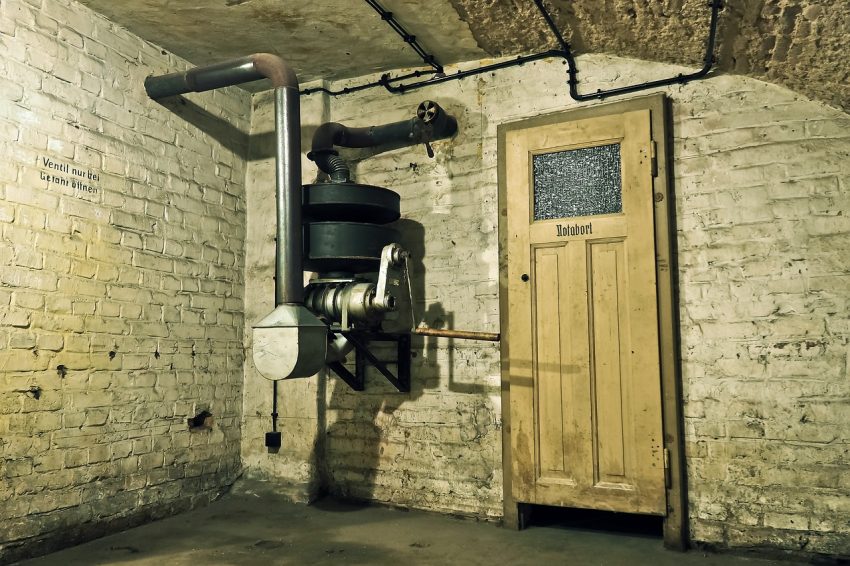Hey there, fellow preppers! So, you’ve decided to take the plunge (literally) and build your own bunker. Smart move. But before you start digging, let’s talk tools. Because trust me, you don’t want to be halfway through your project and realize you’re missing that one crucial piece of equipment. Been there, done that, got the muddy t-shirt.
- The Dirt Mover: Excavator or Backhoe
First things first, you gotta move some earth. Renting a mini excavator or backhoe will save your back and probably your sanity. Look for one with at least a 10-foot digging depth. And hey, if you’ve got the cash and space, buying one might be worth it for maintenance and future projects. Just don’t forget to check if you need a special license to operate it – the last thing you want is a fine along with your new hole in the ground.
[Link: “Bunker Security: Safeguarding Your Underground Sanctuary” – Because once you dig that hole, you’ll want to keep it safe!]
- The Mix Master: Concrete Mixer
Unless you want to mix concrete by hand (trust me, you don’t), a good mixer is essential. Go for at least a 3 cubic feet capacity. Gas-powered ones are great for mobility. Pro tip: calculate your total concrete needs beforehand. A 10×10 foot bunker with 8-inch thick walls needs about 6.5 cubic yards of concrete. That’s a lot of mixing, folks.
- The Metal Maestro: Welding Equipment
Time to channel your inner metalworker. A multi-process welder that can handle MIG, TIG, and Stick welding will cover all your bases. Aim for at least 200 amp output. And for the love of all that’s holy, wear proper protective gear. Your eyebrows will thank you.
[Link: “Off-Grid Power Solutions for Long-Term Bunker Living” – Because your welder needs juice, and lots of it!]
- The Air Guardian: Filtration and Ventilation System
Breathing is kind of important, right? A good air system is non-negotiable. You’ll need HEPA filters, activated carbon filters for those nasty chemicals, and a positive pressure system to keep the bad stuff out. Heads up: some high-grade systems might need special permits. Check with your local authorities – better safe than sorry.
- The Juice Box: Generator
When the grid goes down, you’ll need your own power. Look for at least 7,000 watts for basic bunker operations. Dual fuel capability (gas and propane) is a smart move. And consider a quiet one (under 70 dB) unless you want your bunker to sound like a monster truck rally.
- The Thirst Quencher: Water Filtration and Storage System
Clean water is life, people. Get a robust filtration system with reverse osmosis and UV sterilization. And don’t skimp on storage – 55-gallon food-grade drums are a good start. Just a heads up: some states have weird laws about collecting rainwater. Check your local regs before you start hoarding H2O.
[Link: “Hydroponics in Bunkers: The Ultimate Guide to Growing Fresh Food Underground” – Because plants need water too!]
- The Moisture Muncher: Dehumidifier
Unless you want to live in a damp cave (and trust me, you don’t), a good dehumidifier is crucial. Look for one that can pull at least 70 pints of moisture per day. Your lungs and your stuff will thank you.
- The Hole Maker: Hammer Drill
For those times when you need to make holes in concrete (and there will be many), a beefy hammer drill is your best friend. Go for at least an 8 amp motor. Your wrists will appreciate models with good vibration control.
- The Metal Muncher: Angle Grinder
Cutting rebar, smoothing concrete, this tool does it all. Get one with variable speed control and a quick-change wheel system. And stock up on different types of discs – you’ll need them.
- The Straight Shooter: Laser Level
Nothing ruins a bunker faster than wonky walls. A good laser level will keep everything straight and true. Look for one with 360-degree horizontal and vertical planes. It’s like having a tiny surveyor in your pocket.
[Link: “The Art of Maximizing Space: Emergency Food Storage Solutions for Small Bunkers” – Because a level bunker means more efficient storage!]
Now, before you rush off to start your underground paradise, a word to the wise: check your local laws. Zoning regulations, building permits, utility clearances – boring stuff, I know, but ignore them at your peril. The last thing you want is to finish your bunker only to have some bureaucrat tell you to fill it back in.
So, there you have it, folks. Your ultimate bunker-building toolkit. With these 10 tools, you’ll be well on your way to creating your own subterranean sanctuary. Just remember: measure twice, cut once, and always, always wear your safety gear.
Got any tool tips of your own? Maybe a secret weapon that made your bunker build a breeze? Share in the comments below! Let’s help each other create the best damn bunkers this side of the apocalypse.
Stay safe, stay prepared, and happy digging!



